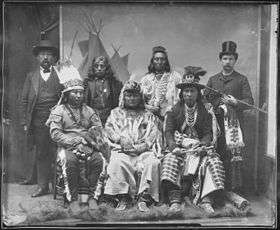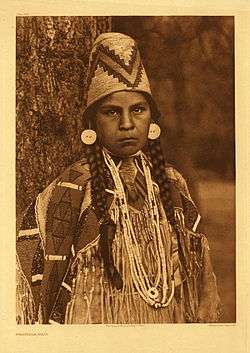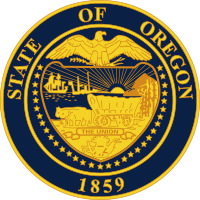Umatilla people
The Umatilla are a Sahaptin-speaking Native American tribe who traditionally inhabited the Columbia Plateau region of the northwestern United States, along the Umatilla and Columbia rivers.[1]

History
Early development

The Umatilla nation was bordered by the Teninos to the West and the Klickitats to north, across the Columbia River.[2] Also by their northern border were the Paluse, Wasco-Wishrams.[2] They had friendly Cayuse, and Walla Walla tribes to the east, Because of their homeland lacked natural defenses, the Umatillas were attacked from the south by groups of Bannocks and Paiutes.[2]
Linguistically, the Umatilla language is part of the Sahaptin division of the Penutian language family — closely related to other peoples of today's Eastern Oregon, Eastern Washington, and the Idaho panhandle.[1] These included the Nez Percé, Cayuse, Walla Walla, Palouse and the Yakima.[1] These peoples were ravaged by smallpox and other infectious diseases contracted from European colonists during the first half of the 19th century and their populations depleted, as they had no immunity.[1]
In 1855 the inland Sahaptin-speaking nations were forced to surrender their historic homelands under treaty to the United States government,[3] in exchange for territorial set-asides on reservations.[1]
Reservation period
Today the Umatilla share land and a governmental structure with the Cayuse and the Walla Walla tribes as part of the federally recognized Confederated Tribes of the Umatilla Indian Reservation. Their reservation is located near Pendleton, Oregon and the Blue Mountains.
A number of places and geographic features have been named after the tribe, such as the Umatilla River, Umatilla County, and Umatilla National Forest. The impoundment of the Columbia River behind the John Day Dam is called Lake Umatilla.
Notable Umatillas
- Donald McKay – scout and leader of the Warm Springs Indians during the Modoc War
- Shoni Schimmel – WNBA Player
- Acosia Red Elk – World Champion Jingle Dress Dancer, Yoga Instructor
See also
Footnotes
- "Umatilla," in Barbara A. Leitch, A Concise Dictionary of Indian Tribes of North America. Algonac, MI: Reference Publications, Inc., 1979; pp. 490-491.
- Hines, Donald M. The Forgotten Tribes, Oral Tales of the Teninos and Adjacent Mid-Columbia River Indian Nations. Great Eagle Publishing. Issaquah, WA. 1991, p. 55.
- Trafzer, Clifford E. (Fall 2005). "Legacy of the Walla Walla Council, 1955". Oregon Historical Quarterly. 106 (3): 398–411. ISSN 0030-4727. Archived from the original on 2007-01-05.
Further reading
- Humphrey, Seth K (1906). . The Indian Dispossessed (Revised ed.). Boston: Little, Brown and Company. OCLC 68571148 – via Wikisource.
